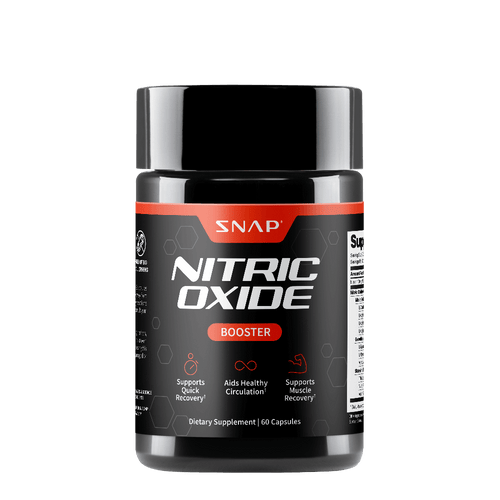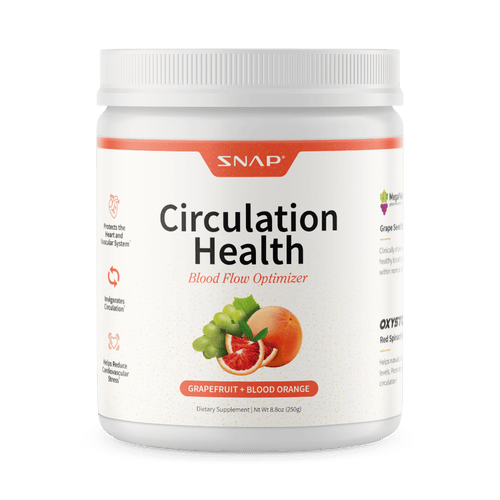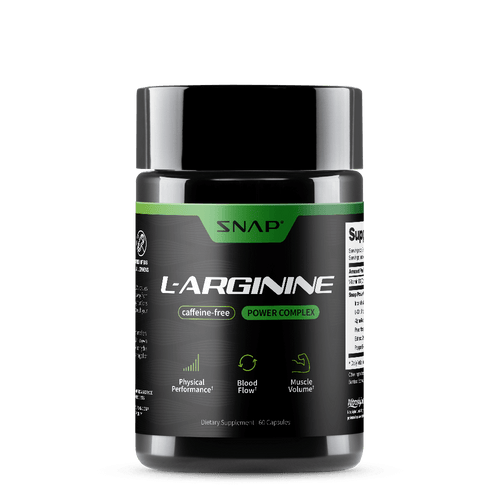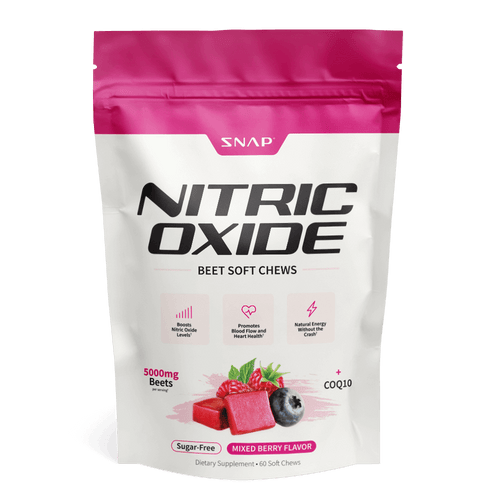Have you ever wondered what makes nitric oxide (NO) so unique among neurotransmitters?
While many neurotransmitters work through direct synaptic connections, nitric oxide takes a different approach. It doesn't need specific receptors to function. Instead, it freely diffuses across cell membranes, influencing a wider range of targets in the body. This ability allows it to play a crucial role in regulating blood flow, nerve signaling, and even cognitive function.
With nitric oxide supplements from trusted brands like Snap Supplements, you can potentially boost your cardiovascular and cognitive health, helping you perform at your best every day.
$40.00

Nitric Oxide Booster (60ct)
Nitric oxide’s versatility is what sets it apart. It’s not just about heart health; it’s about overall vitality. By boosting nitric oxide levels, you can enhance blood circulation, improve cognitive performance, and support your body’s physical efficiency. Imagine the difference it could make in your daily life!
In this blog, we will talk about:
-
The unique functions of nitric oxide and why it's a game changer for your health
-
How nitric oxide influences everything from blood flow to brain function
-
The role of nitric oxide supplements in supporting your health, with options like those from Snap Supplements
So, let's explore how this unique neurotransmitter impacts your body and why it’s essential for optimal health.
Chemical Properties of Nitric Oxide
Nitric oxide (NO) is a unique neurotransmitter with distinct chemical properties. Its small molecular structure, reactive nature, and ability to diffuse easily through cell membranes make it stand out. These characteristics allow nitric oxide to perform various important functions in the body.
Small Molecule Structure
Nitric oxide is a small molecule consisting of one nitrogen atom and one oxygen atom. This simple structure enables it to move freely and rapidly in biological systems.
Unlike larger neurotransmitters, NO doesn't need specific receptors to function. Instead, it can easily penetrate cell membranes, directly influencing cellular activities. This ability makes nitric oxide effective in diverse physiological roles, including vascular regulation and neurotransmission.
$46.00

Circulation Health
$57.00
Reactive Nature
Nitric oxide is highly reactive, which significantly impacts its biological functions.
It reacts easily with other molecules, forming reactive nitrogen species. These species can impact cellular signaling and defensive mechanisms. The reactive nature of NO enables it to participate in immune responses and address oxidative stress.
Its antimicrobial properties help fight infections, while its role in inflammation regulation is crucial for healing processes.
Solubility and Diffusion
Nitric oxide's solubility allows it to diffuse rapidly across membranes, a characteristic critical for its role in cellular signaling.
NO’s diffusion ability enables it to coordinate responses over short distances without delay. It facilitates quick cell communication, which is essential for blood vessel dilation and neurotransmitter release.
Nitric oxide's fast movement across cell membranes enhances its efficiency as a signaling molecule, seamlessly connecting various body parts.
Biosynthesis and Regulation
Nitric oxide is synthesized in your body through specific enzymatic processes and plays a critical role in cellular communication.
This section will explore the enzymes involved in nitric oxide production, the cellular mechanisms for signaling, and the significance of nitric oxide synthases in these processes.
Enzymatic Production
Nitric oxide is produced from the amino acid L-arginine via nitric oxide synthases (NOS). This reaction involves the conversion of L-arginine into nitric oxide and L-citrulline.
It's a two-step process that requires oxygen and several cofactors, such as NADPH. The importance of nitric oxide in various physiological processes makes understanding its synthesis crucial.
Nitric oxide is a neurotransmitter that facilitates communication between nerve cells. Its unique role is due to its gaseous state, which allows it to diffuse easily across cell membranes.
Optimizing synthesis pathways is essential for effectively using nitric oxide, particularly in supplements.
$39.00

L-Arginine
Cellular Signaling Mechanisms
Nitric oxide's cellular signaling involves binding to proteins and affecting processes like vasodilation. This means it helps blood vessels relax, improving blood flow. In neurons, this signaling can influence neurotransmission and neural activity. As a small and reactive molecule, nitric oxide acts locally and rapidly.
In your body, nitric oxide can modulate immune responses and influence cell proliferation. These mechanisms ensure that cells respond to environmental changes quickly. The balance of nitric oxide in cells is vital: too much or too little can lead to health issues.
Role of Nitric Oxide Synthases
There are three main types of nitric oxide synthases: endothelial (eNOS), neuronal (nNOS), and inducible (iNOS).
Each has specific functions.
-
eNOS is vital for cardiovascular health and maintaining blood pressure.
-
nNOS is involved in neural communication, affecting memory and learning.
-
iNOS plays a role in immune defense but can lead to inflammation if unregulated.
These enzymes regulate nitric oxide production by responding to calcium and other signaling molecules. Understanding these enzymes is key to regulating nitric oxide levels in your body.
Balanced nitric oxide synthase activity is essential for overall well-being and is a focus in nutritional supplements designed to support metabolic and cardiovascular health.
$46.00

Circulation Health
$57.00
Biological Functions
Nitric oxide plays a significant role in the human body, influencing various systems through distinct mechanisms. It helps regulate blood flow, offers defensive actions in the immune system, and facilitates brain communication.
Vasodilation Effects
Nitric oxide is crucial for vasodilation, where blood vessels widen to improve blood flow. This effect reduces blood pressure and enhances circulatory function, delivering oxygen and nutrients more efficiently throughout the body.
The widening of blood vessels helps cardiovascular health, reducing the risk of heart-related issues. Nitric oxide improves oxygen delivery and supports physical performance, which is why many athletes focus on increasing their nitric oxide levels.
$85.00

Cardio Health Bundle with FREE Shaker
$122.00
Immune Response
Nitric oxide is an essential player in your body's immune response. It aids in defending against pathogens by signaling to destroy harmful microbes. In this way, nitric oxide helps control infections and regulates immune function.
The molecule achieves this by participating in the process of eliminating invading bacteria and viruses. At the same time, this action can help help soothe inflammatory symptoms, supporting overall immune health.
Nitric oxide can protect healthy tissues from damage by modulating immune responses and maintaining balance in the body’s defensive mechanisms.
Neurotransmission
In the brain, nitric oxide acts as a neurotransmitter, facilitating communication between nerve cells. It is unique because it is a gaseous neurotransmitter, allowing it to diffuse quickly across cell membranes. This characteristic enables it to play a role in synaptic plasticity, which is critical for learning and memory processes.
Nitric oxide contributes to the nervous system's functioning by regulating the widening of small blood vessels in the brain, thereby improving cerebral blood flow. This is essential for maintaining cognitive functions and supporting mental clarity.
Neurotransmitter Characteristics
Nitric oxide is a unique neurotransmitter due to its special characteristics. It is a gaseous signaling molecule that acts differently from traditional neurotransmitters. It also uses retrograde signaling and has a unique way of spreading across cells.
Gaseous Signaling Molecule
Nitric oxide is a gas, unlike other neurotransmitters, which are usually chemicals in liquid form. This gaseous nature allows it to travel quickly through cell membranes. Since it doesn't need specific receptors, nitric oxide can work in unusual ways compared to other neurotransmitters.
Its role involves increasing blood flow and enhancing brain function. Products from Snap Supplements, like those containing nitric oxide, aim to support your health by harnessing this unique property. Understanding how nitric oxide works helps explain its impact on the body.
Retrograde Signaling
Nitric oxide is important because it can signal backward. This retrograde signaling means that the signal travels from the receiving neuron back to the sending neuron in the opposite direction of most neurotransmitters.
This unique method helps adjust and strengthen synaptic connections. It plays a significant role in memory and learning. Providing feedback to the sending neuron influences how strongly synapses form and function. This capability underscores its essential role in brain processes.
Diffuse Transmitter Action
As a diffuse transmitter, nitric oxide doesn't stay confined to a single synapse.
Instead, it can affect nearby neurons and alter entire networks within the brain. Its ability to spread makes it an influential neurotransmitter despite its gaseous form.
This widespread impact allows it to play a critical role in processes like vasodilation and the widening of blood vessels. This action helps improve blood flow and nutrient delivery throughout the body.
Physiological Impacts
Nitric oxide is crucial in regulating blood flow and supporting brain health. It helps maintain efficient circulation and supports nerve function, making it unique among neurotransmitters.
Blood Flow Regulation
Nitric oxide is key in controlling blood vessel dilation.
Relaxing the smooth muscles in your blood vessels allows for increased blood flow. This process can support healthy blood pressure and improve circulation, which is vital for cardiovascular health.
Foods rich in L-citrulline, such as watermelon, aid in producing nitric oxide, further supporting healthy blood flow. Increased circulation due to better nitric oxide levels contributes to more energy and stamina in daily activities and exercise.
$57.00

Nitric Oxide Beet Soft Chews
Neuroprotection and Plasticity
Nitric oxide contributes to neuroprotection by supporting neuron function and communication. During neurological signaling, it enhances cognitive functions like memory and focus. This is achieved through increased cerebral blood flow and oxygen delivery to the brain.
Nitric oxide supports enhanced connections between nerve cells, known as neuroplasticity. It helps in the brain's adaptation and growth and assists in recovery from injury and disease. By optimizing nitric oxide levels, you help protect your brain health and improve overall mental performance.
Maintaining a healthy lifestyle, including a diet with foods boosting nitric oxide, can further promote neuroprotection and brain resilience.
Clinical Relevance
Due to its unique properties, nitric oxide plays a crucial role in various medical fields. It is significant in cardiovascular therapies, potential treatments for neurodegenerative disorders, and its use as a diagnostic marker.
Understanding these applications provides insight into their importance in modern medicine.
Cardiovascular Therapeutics
Nitric oxide is essential for maintaining healthy blood vessels.
It helps relax and expand blood vessels, making blood flow easier. This can support healthy blood pressure and improve overall heart health. Medications that release or enhance nitric oxide levels treat high blood pressure and heart diseases.
Research indicates that increased nitric oxide production can reduce the risk of heart attacks and strokes. Patients with cardiovascular concerns may benefit from therapies that optimize nitric oxide levels.
Neurodegenerative Disorders
Nitric oxide has potential therapeutic roles in treating neurodegenerative disorders, such as Alzheimer's and Parkinson’s diseases. It acts as a neurotransmitter, improving blood flow to the brain and supporting cognitive function. Emerging studies suggest it might help slow disease progression or improve symptoms.
Nitric oxide's ability to enhance nerve communication is noteworthy. This could aid in developing new treatment strategies for disorders characterized by nerve cell damage. Patients and caregivers might find this research area promising, as it represents a step towards innovative therapies.
Diagnostic Marker
Nitric oxide levels can serve as a diagnostic marker for various health conditions. They can indicate inflammation or oxidative stress levels in the body. Doctors can gain valuable insights into a patient's health status by measuring nitric oxide levels.
For instance, alterations in nitric oxide levels may signal cardiovascular issues or immune system dysfunction. Testing for these levels can be part of routine health assessments.
Understanding these diagnostic applications can guide personalized treatment plans and interventions.
Research and Discoveries
Nitric oxide (NO) is unique among neurotransmitters due to its gaseous state and ability to diffuse across cell membranes easily. Unlike other neurotransmitters that are stored in vesicles, NO is synthesized on demand and acts quickly without needing traditional receptor sites.
Key Discoveries:
-
NO plays a role in widening blood vessels, impacting blood pressure regulation.
-
It stimulates bodily processes in muscle relaxation, affecting breathing and digestion.
Researchers found NO is crucial for brain and cellular communication. It supports memory and learning by enhancing signaling pathways in the brain. This role in cognitive function highlights its unique nature compared to other neurotransmitters.
Clinical Research Areas:
-
Cardiovascular health
-
Immune response
-
Neurotransmission
Athletes and fitness enthusiasts are interested in NO for performance enhancement.
Innovative Applications:
Using natural ingredients, Snap Supplements leverages NO’s benefits in formulations for heart health and effective nutrient transport. This includes soft chews and gummies that encourage cardiovascular wellness and overall vitality.
Advancements in NO research continue to reveal its significant influence on human health, making it a critical focus in science and supplementation.
Frequently Asked Questions
Nitric oxide is a unique neurotransmitter that influences several essential functions in the body. Here, we’ll answer some of the most common questions to help you understand its powerful role and how you can harness its benefits.
How is nitric oxide synthesized and released compared to other neurotransmitters?
Nitric oxide is synthesized from L-arginine by the enzyme nitric oxide synthase. Unlike other neurotransmitters, it is not stored in vesicles but is produced on demand. It diffuses freely across cell membranes, making its release mechanism stand out.
What role does nitric oxide play in neurotransmission, and how does this differ from traditional neurotransmitter mechanisms?
In neurotransmission, nitric oxide acts as a signaling molecule but does not bind to typical receptors. Instead, it diffuses into cells and influences intracellular targets directly. This contrasts with traditional neurotransmitters, which bind to specific receptors on cell surfaces to exert their effects.
In what ways does the signal transduction pathway of nitric oxide differ from that of other neurotransmitters?
Nitric oxide activates guanylate cyclase, increasing cyclic GMP levels, which regulates various cellular functions. Other neurotransmitters typically activate receptor-mediated signal transduction pathways involving changes in ion channel activity or second messenger cascades like cyclic AMP.
How does the solubility and diffusion of nitric oxide influence its function as a neurotransmitter?
Nitric oxide’s high solubility and ability to diffuse across cell membranes allow it to act over a broader area. This characteristic enables it to impact multiple cells simultaneously rather than targeting specific synapses like traditional neurotransmitters.
What physiological effects does nitric oxide have that are not common to other neurotransmitters?
Nitric oxide has unique roles in vasodilation, helping support healthy blood pressure and flow. It also influences immune responses and cellular defense mechanisms.
How does the relatively short lifespan of nitric oxide impact its function compared to other neurotransmitters?
Nitric oxide's short lifespan only lasts a few seconds, necessitating its rapid synthesis and diffusion. This quick action facilitates brief and targeted signaling, contrasting with longer-lasting effects seen with other neurotransmitters.